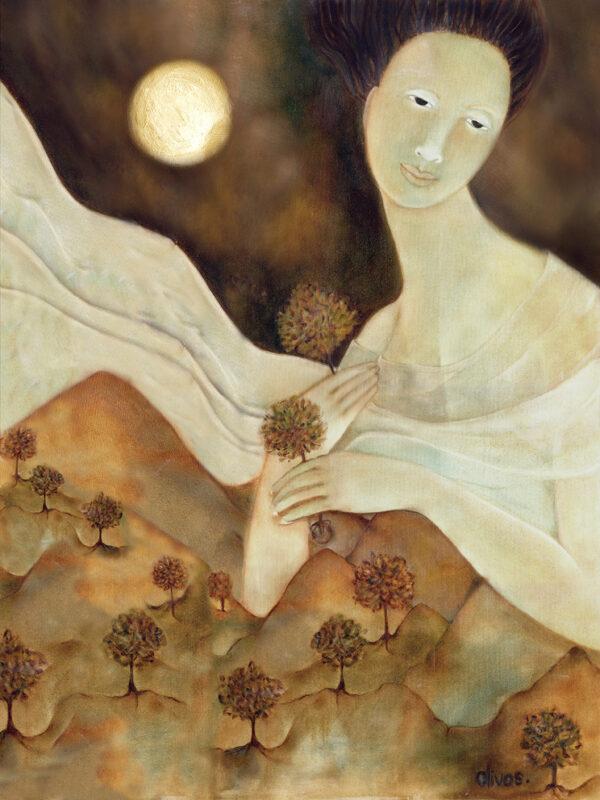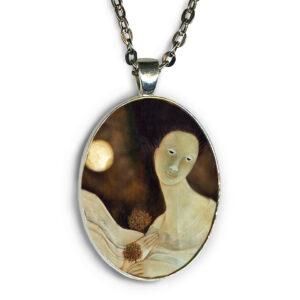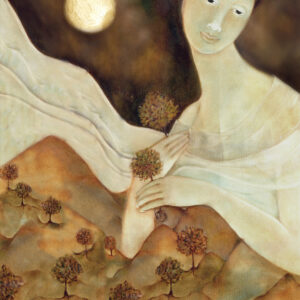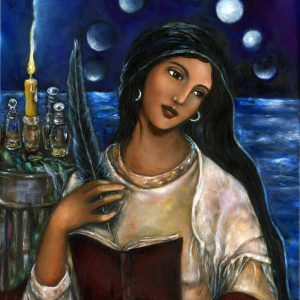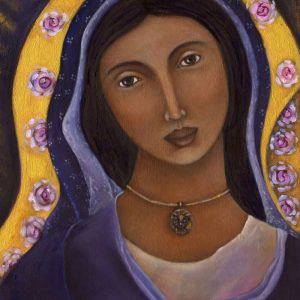Asherah, Canaanite Goddess and consort of Yahweh. She is known as the “Queen of the Heavens”, also known as Ishtar in Mesopotamia, Ashtoret in Syria-Palestine as Ashtartu in Egypt, and to the Greeks She was Astarte. The names all share a root in a Semitic word that means irrigation, as such, she is associated with growth (particularly groves and fruit trees) and waters that give fertility to the land. She is the Primordial and Supreme Goddess of Creation, as powerful as God. She is omnipotent, omnipresent, omniscient, Sacred and Divine.
Her worshippers used small clay images on their Altars, most of which were commercially manufactured from molds by Hebrew and Canaanite artisans, intended for home use, and they celebrated Her with fertility rituals and festivals. However She is most often represented by the Asherah– a Sacred tree or pole planted in the ground, to honor the Goddess, and emphasizing Her relationship to trees; in fact, Bible scholars report that the Christmas tree was initially venerated in honor of the Goddess. Whether the Hebrews learned her worship from the Canaanites or whether Goddess Asherah is an indigenous Hebrew Goddess remains a mystery, but we know that She was important enough to be mentioned 40 times in the Bible (one of Her well known Priestesses was Jezebel).
Asherah and Astarte-Anath were routinely worshipped. And in fact, we find that for about 3,000 years, the Hebrews worshipped female deities which were later eradicated only by extreme pressure of the male-dominated priesthood.
The Star of David, two triangles “embracing” became the coded symbol for God & Goddess locked in a “creating” posture.
This cult of the feminine goddess, though often repressed, remained a part of the faith of the Jewish people. Goddesses answered the need for mother, lover, queen, intercessor … and even today, lingers cryptically in the traditional Hebrew Sabbath invocation. (The Hebrew Goddess by Raphael Patai )
Some places in the Bible where Asherah is mentioned:
- Now summon the people from all over Israel to meet me on Mount Carmel. And bring the four hundred and fifty prophets of Baal and the four hundred prophets of Asherah, who eat at Jezebel’s table.”—1 Kings 18:19
- Jeremiah 7:18 Do you not see what they are doing in the cities of Judah and in the streets of Jerusalem? (18) The children gather wood, the fathers kindle fire, and the women knead dough to make cakes for the Queen of Heaven, and they pour out libations to other gods in order to provoke me.
- Cakes made of wheat or barley were offered in the temple. They were salted, but unleavened ( Exodus 29:2 ; Leviticus 2:4 ). In idolatrous worship thin cakes or wafers were offered “to the queen of heaven” ( Jeremiah 7:18 ; 44:19 ).
- Then Yahweh said to me, ‘Go again, love a woman who is loved by a lover and is committing adultery, just like the love of Yahweh for the children of Israel, who look to other mighty ones and love the raisin cakes of the pagans.'”Hosea 3:7
- “Even as the LORD loves the people of Israel, though they turn to other gods and are fond of raisin cakes.” Hosea 3:1 “Raisin cakes: offerings to the fertility goddess Asherah, the female counterpart of Baal; cf Jer 7:18; 44:19.” The name Baal means simply Lord or husband. In modern Hebrew, the word for husband is baal, used by millions of Israel wives to this day.
- “Do not set up any wooden Asherah beside the altar you build to the Lord your God, and do not erect a sacred stone, for these the Lord your God hates.”—Deuteronomy 16:21-22
- “Take your father’s bull and a second bull seven years old, and pull down the altar of Baal which belongs to your father, and cut down the Asherah that is beside it.”—Judges 6:25
- “For they also built for themselves high places and sacred pillars and Asherim on every high hill and beneath every luxuriant tree.”—1 Kings 14:23
- He broke in pieces the sacred pillars and cut down the Asherim and filled their places with human bones.”—2 Kings 23:14
Blessed be our Sacred Mothers and Goddesses!
Related products
-
Asherah, Queen of the Heavens. Classic Elegance Pendant Necklace
$35.00 – $60.00 Select options -
Ashera Queen of the Heavens Reproduction on Canvas
$38.00 – $800.00 Select options -
Mary Magdalene Reproduction on Canvas
$38.00 – $800.00 Select options -
Mother Mary Reproduction on Canvas
$38.00 – $800.00 Select options

